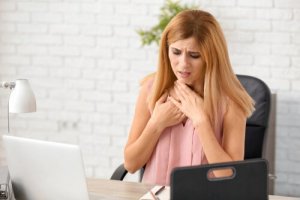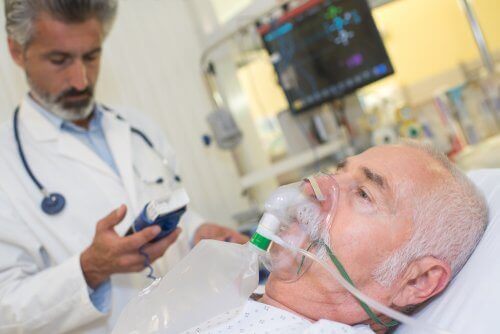Shortness of Breath: The Main Causes and Solutions


Written and verified by the doctor Elisa Martin Cano
Shortness of breath is known in medicine as dyspnea and can be due to multiple causes. What’s clear is that it’s a very unpleasant sensation. Plus, it may be a sign that there are some very serious underlying health problems.
For example, shortness of breath is one of the symptoms of the SARS-CoV-2 coronavirus infection, the cause of the current COVID-19 pandemic. It is, therefore, important to know what to do if you suffer from it.
Here are the most common causes and some actions that can be taken.
What is shortness of breath?
As we’ve already said, shortness of breath is also known as dyspnea. It’s the subjective feeling that we’re having difficulty breathing and that the air isn’t reaching the lungs as it should.
Normally, breathing takes place involuntarily and unconsciously. When someone has shortness of breath, then the uncomfortable situation it causes can make the person feel very afraid, thus making things even worse.
You may be interested in: Chronic Obstructive Pulmonary Disease (COPD)
What are the main causes of shortness of breath?
Anxiety
Anxiety is one of the main causes of shortness of breath in people who don’t have any other health problems. When faced with an anxiety attack, a panic attack, or highly stressful situations, the sufferer may feel short of breath or feel like they are suffocating.
In these cases, the key is to learn how to identify these attacks. When a person suffers from an anxiety attack, they’ll first need to sit down to try to calm down. Then, they need to try to breathe normally to try to control the situation.
Often, it’s necessary to seek professional help from an expert who can teach them specific tools to help them cope with these types of situations and overcome them. There’s nothing wrong with getting some extra help. In fact, it can really make a difference and help prevent future attacks!

Excessive exercise
Sometimes, too much exercise, or carrying out exercise incorrectly, can lead to shortness of breath. This can happen both to people who are used to playing sports and to people who are in poor shape. However, it’s more common in people who have a sedentary life or who are overweight.
In these cases, the key is to adapt the activity to your individual physical condition and then increase the intensity as your capacity increases. Little by little, we’ll be able to carry out more strenuous exercises.
When you feel shortness of breath, then you must slow down the pace of exercise and try to calm your breathing without panicking.
Heart problems
Your heart pumps blood throughout your body. When the heart isn’t working properly for any of several different reasons, then it won’t carry out this pumping of blood correctly. This usually happens when a person with heart problems carries out an activity that requires an increased heart rate.
This means that certain parts of the body won’t be getting the blood and oxygen they need. As a result, they’ll send a signal to the central nervous system and this will manifest itself as a feeling of shortness of breath. It may also be accompanied by chest pain.
In these cases, it’s important to go and see a specialist. The specialist will establish the treatment and the guidelines to follow adapted to your particular case.
You may be interested in: Oxygen Therapy: What Is it and What’s its Purpose?
Pregnancy
When a woman is in an advanced stage of pregnancy, then the placenta and the baby’s presence mean that the mother’s diaphragm has less room to expand. The result of this is that the lungs are unable to expand properly, causing the mother to feel short of breath.
This is quite normal for most pregnant women. In these cases, it’s important to stay calm. Sitting down on cushions at a 45º angle can help to control this feeling. Once seated, the woman should try to breathe normally and not panic.
The same applies when sleeping, and pregnant women should avoid sleeping horizontally. The horizontal position worsens the feeling of shortness of breath. This is because, due to gravity, there’s more pressure on the diaphragm.
Breathing problems
Here we can bring together several very different pathologies. Allergy attacks, asthma, bronchitis, COPD, pneumonia, or any condition of the airways can produce a sensation of shortness of breath.
In this category, we can also include respiratory failure due to coronavirus. Dyspnea or shortness of breath is one of the symptoms of SARS-CoV-2 coronavirus infection, the cause of the current COVID-19 pandemic.
In these cases, the most important thing to do is to go to see a specialist. The doctor will be the one to diagnose which respiratory pathology needs to be treated and will establish suitable treatment, if necessary. The treatment may range from rest to more specific treatments, such as antibiotics.

Obesity
The case with obesity is similar to that of pregnancy. When fat accumulates in the abdominal area, it presses on the diaphragm and makes it difficult to expand, causing the uncomfortable sensation of dyspnea.
In these cases, we recommend that you go to a nutrition and dietetics specialist, who will give you some guidelines on how to lose weight healthily and responsibly.
Neuromuscular diseases
Different neuromuscular diseases can affect both the diaphragm and the muscles of the thoracic cavity, which results in the respiratory system not working correctly. In these cases, a specialist will need to diagnose and prescribe appropriate treatment.
Conclusion: What to do when you feel short of breath
At times when you feel short of breath, the most important thing is to remain calm. You should sit down in a quiet place and try to control your breathing.
If, after a while, it doesn’t return to normal, then call your doctor or go to the emergency services, depending on the intensity of the symptoms.
If the dyspnea is caused by other basic illnesses, then you should go to the specialist to have the necessary tests done. It’s important to follow the treatment that they prescribe to control the symptoms as much as possible.
All cited sources were thoroughly reviewed by our team to ensure their quality, reliability, currency, and validity. The bibliography of this article was considered reliable and of academic or scientific accuracy.
- Basara L, Begić NJ, Grle SP, Jakopović M, Samaržija M. Dyspnea from neuropsychyatric perspective: A narrative review. Vol. 30, Psychiatria Danubina. Medicinska Naklada Zagreb; 2018. p. 11–20.
- Martínez-Moragón E, Perpiñá M, Belloch A. ¿Influye la experiencia en la percepción de disnea? Arch Bronconeumol. 2006 Apr 1;42(4):171–4.
- Percepción de la disnea y cumplimiento terapéutico en pacientes con asma – ScienceDirect [Internet]. [cited 2020 Apr 19]. Available from: https://www.sciencedirect.com/science/article/pii/S0300289608721148
- Otro diagnóstico diferencial de disnea en paciente joven: a propósito de un caso de neoplasia cardiaca – Dialnet [Internet]. [cited 2020 Apr 19]. Available from: https://dialnet.unirioja.es/servlet/articulo?codigo=7047253
This text is provided for informational purposes only and does not replace consultation with a professional. If in doubt, consult your specialist.








